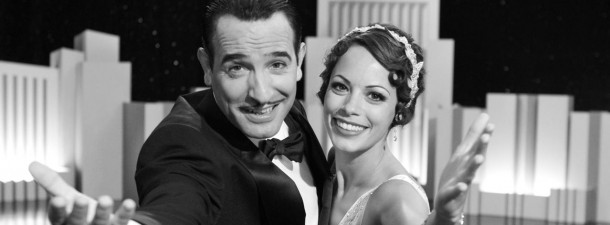Movie Review: ‘The Artist’
February 29, 2012
To some, “The Artist” first sounds like 100 minutes of silence and overacting. I would like to take the opportunity to dispel that notion and raise you two thumbs.
I would first like to cover briefly some of the common misconceptions about silent films, the main being that they are not really silent, because while all the acting is done through expressions, gestures, body language and what we, the audience, can imply from them, there is still dialogue. Mostly short and sweet dialogue, but dialogue all the same. This is done through the use of intertitles, which according to the third edition of “Film History: An Introduction” by Thompson and Bordwell, are basically separate frames given to key dialogue, usually midway through a character’s “speaking,” and sometimes even for noted noises.
To put it in perspective, the difference between an intertitle and a subtitle is that subtitles appear directly on the screen with the film and intertitles do not. As for the actual sound, it comes from the music that accompanies the film, which back when silent films were popular was generally performed live in the picture palaces where they were viewed, ranging from a full orchestra to a single piano player, in turn demonstrating that “silent” pictures weren’t quite so silent after all.
The combination of the music and the intertitles thus creates a language of its own, which is effectively carried out in “The Artist,” allowing its audience to relive a part of film history. In particular, the part when silent films turned into talking films.
The story of the film centers on the silent film star George Valentin (Jean Dujardin) who, with his adorable dog Uggie, has just started to gain recognition and fame. While standing amongst his adoring fans, he meets Peppy Miller (Berenice Bejo), an aspiring dancer looking for her foot in the door. From that moment on, the two form a bond that the film loops in and out of, while centering on Valentin and his actions after being faced with the decision to turn from silent to sound pictures. He immediately chooses silent in declaration that sound films are only a fad, which we all obviously know will be proved false as the film continues. Thus Valentin’s plight becomes heartbreaking as we watch his stubborn attempts to keep the silent film alive while Miller climbs the charts in her embrace of the new era. Through the combined efforts of Miller and Uggie, however, Valentin may just change his mind.
Going in to this film, I was immensely curious as to how it would merge the style of yesteryear with the audience of today, because as endearing and magnificent as silent films are, they can feel slow when one is “not in the mood” to be patient with them. I worried “The Artist” would possess a piece of this quality and feel not only tedious but be unoriginal in contrast to the early silent films, of which many are surprisingly complex, and thus alienate the silent movie genre from future audiences. I could not have been more wrong in my first judgments, for this story was as beautiful as the actors portraying it.
I continued to be surprised in the handful of intertitles in this film. I saw the film with a friend who, before it started, posed me the question of how a silent film could be Academy nominated for a screenplay. At the time, I remarked that it was unusual but not unheard of, noting it was due to the use of the intertitles. As the film progressed, I realized that telling the story was instead up to the skill of the actors, with their use of fluid and believable body language, consisting of their articulated gestures and facial expressions. It was not up to the words on the intertitles at all, not even remotely, which is what makes this film so amazing, because it reminds us just how much we can communicate and infer without the use of words or actual sound.
The art direction and general execution of the time period I found to be extremely well-executed and thought out, evoking the spirit of that moment in history effectively. The cinematography was striking as well, allowing the audience to see some beautifully framed shots that made the story all the more dazzling. In addition, Valentin’s lovable companion Uggie was extremely well trained and a pleasure to see on the screen, imitating many of the same expressions as Valentin, which was often hysterical.
My only criticisms of the film come from a few small holes in the plot, which to remark on specifically would ruin the story, so I will keep it vague. They were points that I felt were unexplained or supposed to be inferred, but due to the fast pace of this film and it being under the two-hour mark, I thought could have been allotted the time to be given more detail.
“The Artist” is an excellent and delightful film that people will find universally appealing, due to the story being relatable to a wide audience. It accurately captures the allure and charm of the early silent pictures and combines it with the fresh, modern-day technique and the stunning star power we have today, which makes this film a new classic. Even if you are still on the fence as to how a silent film can hold your attention for 100 minutes, I ask you to take my word for it, because I believe “The Artist” will change your mind.







